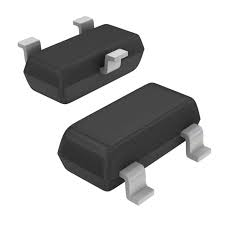MMBT2907ALT1G
Part Number: MMBT2907ALT1G
Manufacturer: onsemi
Description: IC BUFFER NON-INVERT 5.5V SC88
Shipped from: Shenzhen/HK Warehouse
Stock Available: Check with us
ICRFQ.com - Electronic Components Distributor in China Since 2003

Part Number: MMBT2907ALT1G
Manufacturer: onsemi
Description: IC BUFFER NON-INVERT 5.5V SC88
Shipped from: Shenzhen/HK Warehouse
Stock Available: Check with us
| Datasheet | |
|---|---|
| Category | Discrete Semiconductor Products |
| Family | Transistors – Bipolar (BJT) – Single |
| Manufacturer | ON Semiconductor |
| Series | – |
| Packaging | Tape & Reel (TR) |
| Part Status | Active |
| Transistor Type | PNP |
| Current – Collector (Ic) (Max) | 600mA |
| Voltage – Collector Emitter Breakdown (Max) | 60V |
| Vce Saturation (Max) @ Ib, Ic | 1.6V @ 50mA, 500mA |
| Current – Collector Cutoff (Max) | 10nA (ICBO) |
| DC Current Gain (hFE) (Min) @ Ic, Vce | 100 @ 150mA, 10V |
| Power – Max | 300mW |
| Frequency – Transition | 200MHz |
| Operating Temperature | -55°C ~ 150°C (TJ) |
| Mounting Type | Surface Mount |
| Package / Case | TO-236-3, SC-59, SOT-23-3 |
| Supplier Device Package | SOT-23-3 (TO-236) |
The goal of this article is to give a complete guide to the MMBT2907ALT1G transistor, which is a bipolar junction transistor (BJT) that can be used in a wide range of situations. Understanding the features, specifications, and uses of this transistor is important for people who are interested in electronics, have a hobby with electronics, or work in areas that use electronics.
The MMBT2907ALT1G is a PNP transistor that comes in a surface-mount package. This makes it good for small circuit designs with limited room. It works well and is known for its high voltage power, ability to handle current, and fast switching speed.
With these features and specs, the MMBT2907ALT1G transistor can be used for a wide range of uses, such as amplifiers, audio circuits, switching circuits, voltage regulators, oscillators, and logic level translation circuits. It is an important part of current electronic designs because it is small, can handle high voltage, and works well.
By knowing what the MMBT2907ALT1G transistor can do and what it can’t do, engineers and hobbyists can use its features to make new and safe electronic circuits.
Bipolar Junction Transistors (BJTs) are three-layer semiconductor devices that are often used in electronic circuits for amplification, switching, and signal processing. They are made up of P-type (positively charged) and N-type (negatively charged) parts of semiconductor materials.
A BJT works because of the relationship between two types of charge carriers: electrons and holes. Electrons make up most of the charge carriers in N-type material, while holes make up most of the charge carriers in P-type material. BJTs have three parts: the emitter, the base, and the collection.
When a small current runs through the base-emitter junction (called “forward biasing”), it causes a larger current to flow through the collector-emitter junction (called the “collecting region”), which lets the transistor boost signals or control the flow of current. This is because the transistor can change the amount of charge carriers going through the base area, which controls the flow of current.
Bipolar Crossroads Transistors (BJTs) are three-layer semiconductor devices that are often used to boost, switch, and process signals in electrical circuits. They are made of semiconductor materials with P-type (positively charged) and N-type (negatively charged) parts.
The way a BJT works depends on how electrons and holes interact with each other. Most of the charge carriers in N-type material are electrons, while most of the charge carriers in P-type material are holes. The transmitter, the base, and the collector are the three parts of a BJT.
When a small current flows through the base-emitter junction, which is called “forward biasing,” it causes a bigger current to flow through the collector-emitter junction, which is called the “collecting region.” This lets the transistor boost signals or control the flow of current. This is because the transistor can control the flow of current by changing how many charge carriers go through the base area.
It is important to check the MMBT2907ALT1G transistor’s datasheet and application notes, which are given by the manufacturer, for specific instructions and suggestions on how to use, bias, and run the device. If you follow these rules, the transistors in your electrical circuits will work more reliably and last longer.
The MMBT2907ALT1G transistor is an important part of current electronic circuits because it works well and is reliable in a wide range of situations. With its impressive high voltage capability, current handling capacity, fast switching speed, and small surface-mount package, this transistor lets engineers, hobbyists, and pros make high-performance electronic designs.
At ICRFQ, we know how important good customer service and help are. Our team is committed to helping you at every step, responding quickly and giving you excellent help. No matter if you’re a professional engineer or an enthusiastic hobbyist, our experts are ready to help you use the MMBT2907ALT1G transistor to its full potential and reach your goals. Get in touch with us right away to see how our customer service is different.
Don’t pass up the chance to make your tech projects better. Let us be your trusted partner when it comes to finding the right parts for your needs. Contact us today to find out how to use the MMBT2907ALT1G transistor to its fullest in your projects. Together, we can make technological wonders that work well, are reliable, and are at the cutting edge of technology.
WhatsApp us